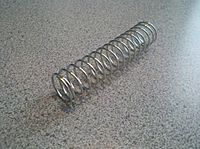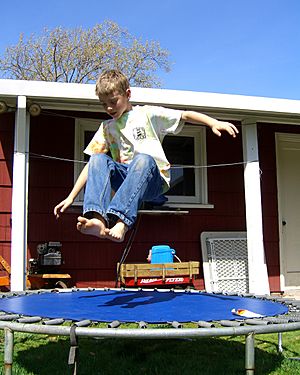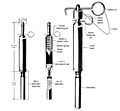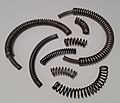Spring (device) facts for kids
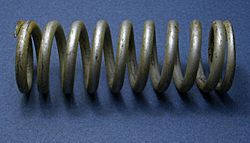

A spring is a device typically made of metal, usually steel.
The metal can be compressed (squeezed). When the compression force is removed, the spring returns to its original length. The metal is usually spring steel, and it is wound tightly. There is lot of varitions with size and type, example some springs have designed for pulling, not pushing. Gas-springs are often used with vehicles tailgate.
Contents
History
Simple non-coiled springs were used throughout human history e.g., the bow (and arrow). In the Bronze Age more sophisticated spring devices were used, as shown by the spread of tweezers in many cultures. Ctesibius of Alexandria developed a method for making bronze with spring-like characteristics by producing an alloy of bronze with an increased proportion of tin, and then hardening it by hammering after it is cast.
Coiled springs appeared early in the 15th century, in door locks. The first spring powered-clocks appeared in that century. They evolved into the first large watches by the 16th century.
In 1676 British physicist Robert Hooke discovered the principle behind springs' action, that the force it exerts is proportional to its extension, now called Hooke's law.
Uses
- Vehicles: Vehicle suspension, Leaf springs
- Watches: Balance springs in mechanical timepieces and spring-loaded bars for attaching the bands and the clasps.
- Mini Drill
- Jewelry: Clasp mechanisms.
- Lock mechanisms: Key-recognition and for coordinating the movements of various parts of the lock.
- Pop-open devices: CD players, Tape recorders etc.
- Pens
- Spring mattresses
- Slinky
- Trampoline
- Pogo stick
- Spring shoes
- Spring reverb
- Buckling spring keyboards
- Upholstery: Upholstery coil springs
- Toy
- Educational
- Airsoft gun
- Firearms
- Reverberation in electronic organs
Images for kids
-
The English longbow – a simple but very powerful spring made of yew, measuring 2 m (6 ft 7 in) long, with a 105 lbf (470 N) draw weight, with each limb functionally a cantilever spring.
-
Military booby trap firing device from USSR (normally connected to a tripwire) showing spring-loaded firing pin
-
A spiral torsion spring, or hairspring, in an alarm clock.
-
Leaf spring on a truck
See also
 In Spanish: Resorte para niños
In Spanish: Resorte para niños


